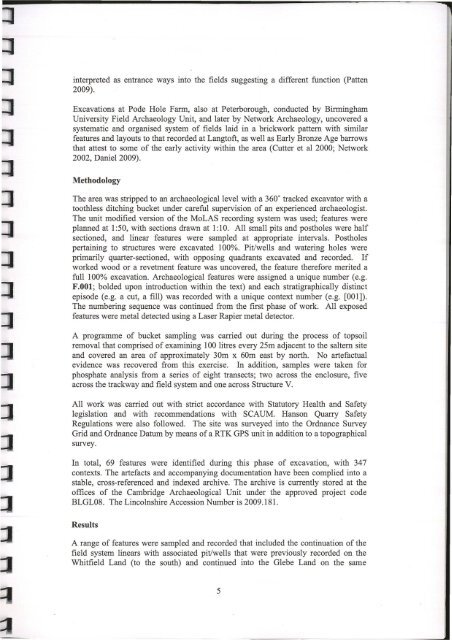Further Excavations At Langtoft. Lincolnshire www - Archaeology ...
Further Excavations At Langtoft. Lincolnshire www - Archaeology ...
Further Excavations At Langtoft. Lincolnshire www - Archaeology ...
You also want an ePaper? Increase the reach of your titles
YUMPU automatically turns print PDFs into web optimized ePapers that Google loves.
interpreted as entrance ways into the fields suggesting a different function (Patten<br />
2009).<br />
<strong>Excavations</strong> at Pode Hole Farm, also at Peterborough, conducted by Birmingham<br />
University Field <strong>Archaeology</strong> Unit, and later by Network <strong>Archaeology</strong>, uncovered a<br />
systematic and organised system of fields laid in a brickwork pattern with similar<br />
features and layouts to that recorded at <strong>Langtoft</strong>, as well as Early Bronze Age barrows<br />
that attest to some of the early activity within the area (Cutter et al 2000; Network<br />
2002, Daniel 2009).<br />
Methodology<br />
The area was stripped to an archaeological level with a 360° tracked excavator with a<br />
toothless ditching bucket under careful supervision of an experienced archaeologist.<br />
The unit modified version of the MoLAS recording system was used; features were<br />
planned at 1:50, with sections drawn at 1:10. All small pits and postholes were half<br />
sectioned, and linear features were sampled at appropriate intervals. Postholes<br />
pertaining to structures were excavated 100%. Pit/wells and watering holes were<br />
primarily quarter-sectioned, with opposing quadrants excavated and recorded. If<br />
worked wood or a revetment feature was uncovered, the feature therefore merited a<br />
full 100% excavation. Archaeological features were assigned a unique number (e.g.<br />
F.001; bolded upon introduction within the text) and each stratigraphically distinct<br />
episode (e.g. a cut, a fill) was recorded with a unique context number (e.g. [001]).<br />
The numbering sequence was continued from the first phase of work. All exposed<br />
features were metal detected using a Laser Rapier metal detector.<br />
A programme of bucket sampling was carried out during the process of topsoil<br />
removal that comprised of examining 100 litres every 25m adjacent to the saltern site<br />
and covered an area of approximately 30m x 60m east by north. No artefactual<br />
evidence was recovered from this exercise. In addition, samples were taken for<br />
phosphate analysis from a series of eight transects; two across the enclosure, five<br />
across the trackway and field system and one across Structure V.<br />
All work was carried out with strict accordance with Statutory Health and Safety<br />
legislation and with recommendations with SCAUM. Hanson Quarry Safety<br />
Regulations were also followed. The site was surveyed into the Ordnance Survey<br />
Grid and Ordnance Datum by means of a RTK GPS unit in addition to a topographical<br />
survey.<br />
In total, 69 features were identified during this phase of excavation, with 347<br />
contexts. The artefacts and accompanying documentation have been complied into a<br />
stable, cross-referenced and indexed archive. The archive is currently stored at the<br />
offices of the Cambridge Archaeological Unit under the approved project code<br />
BLGL08. The <strong>Lincolnshire</strong> Accession Number is 2009.181.<br />
Results<br />
A range of features were sampled and recorded that included the continuation of the<br />
field system linears with associated pit/wells that were previously recorded on the<br />
Whitfield Land (to the south) and continued into the Glebe Land on the same<br />
5

















